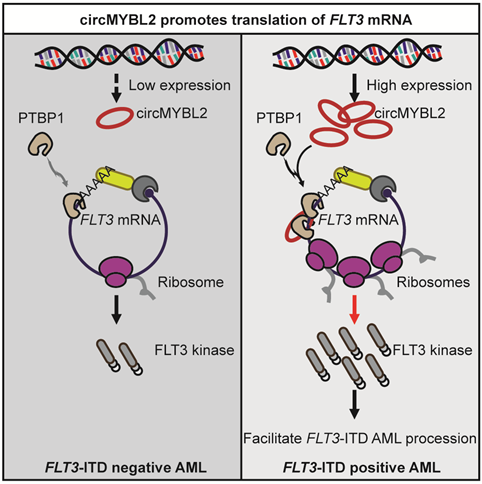Novel function of circRNAs on translational regulation: CircMYBL2 regulates FLT3 translation by recruiting PTBP1 to promote FLT3-ITD AML progression
Source: School of Life Sciences
Written by: School of Life Sciences
Edited by: Wang Dongmei
Internal tandem duplication (ITD) mutations within the FMS-like tyrosine kinase-3 (FLT3) occur in up to 30% of acute myeloid leukemia (AML) patients and confer a very poor prognosis. The oncogenic form of
FLT3 is an important therapeutic target, and inhibitors specifically targeting FLT3 kinase can induce complete remission; however, relapse after remission has been observed due to acquired resistance with secondary mutations in FLT3, highlighting the need for new strategies to target
FLT3-ITD mutations.
Recently, a team led by Professor Yueqin Chen at the School of Life Sciences of Sun Yat-sen University addresses a novel mechanism of circRNAs to regulate the progression of
FLT3-ITD AML. They discovered that a circRNA circMYBL2, which is more highly expressed in AML patients with
FLT3-ITD mutations than in those without the
FLT3-ITD mutation, can specifically regulate the proliferation and the differentiation of
FLT3-ITD AML cells in vitro and in vivo. Mechanistically, circMYBL2 enhanced the translational efficiency of FLT3 kinase by increasing the binding of PTBP1 to FLT3 mRNA. Moreover, circMYBL2 knockdown impaired the cytoactivity of inhibitor-resistant
FLT3-ITD-positive cells, with a significant decrease in FLT3 kinase expression. Thus, this study reveals a circRNA that specifically influences
FLT3-ITD AML and regulates FLT3 kinase levels through translational regulation, suggesting that circMYBL2 may be a potential therapeutic target for
FLT3-ITD AML. The proposed working model is shown below.

Schematic depicting the dominant function of circMYBL2 on the translational efficiency of FLT3 kinase
This study not only provided a new therapeutic strategy for
FLT3-ITD leukemia, but also disclosed a novel mechanism of circRNAs on translational regulation.
This research was supported by National Key R&D Program of China (No. 2017YFA0504400) and National Natural Science Foundation of China (No. 81770174 and 31700719). The above-mentioned results were published in
Blood 2019; 134 (18): 1533-1546 and were chosen as the cover story by the Editor-in Chief.
Link to the paper:
http://www.bloodjournal.org/content/early/2019/08/06/blood.2019000802
